“The least deviation from the truth is multiplied later a thousand fold.”
– Aristotle
Time to set out on a little puff pastry adventure. I’m following the methods learned in my current pastry classes rather than how I learned to make this back in “regular” cooking school years ago, because I want to see the differences, if any. For this particular walk-through I’m using margarine, something I don’t normally use, simply because my professor gave me a large piece of a particular margarine that he likes, that contains an amount of flour so that it’s ready for use in various pastries that would normally require mixing the two together. I prefer to use butter, more expensive or not, simply because, well, as far as I’m concerned, margarine is far less healthy, and even though I grew up on the stuff, it just doesn’t taste right after you’ve had things made with good quality butter. The major difference for something like puff pastry is that margarine doesn’t melt as fast as butter so you can often get in 2-3 “folds” before having to refrigerate it, whereas butter you pretty much have to refrigerate it every time, perhaps getting away with a 2nd fold now and again.
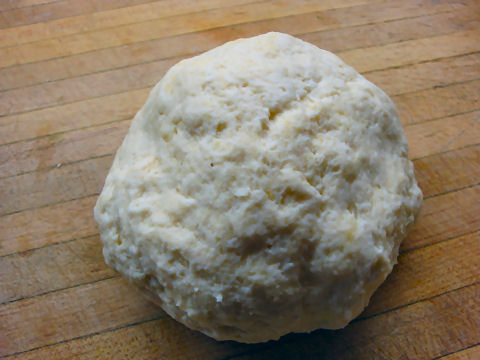
First, make a basic dough – here simply 300 grams of cake flour, 10 grams salt, 1 egg, and enough water to bring it together. The egg may, perhaps, add a small amount of structure, but it’s major purpose is actually to add some color to the dough – you could just use a couple of egg yolks and get an even richer color. Most puff pastry recipes out there probably don’t call for egg and it’s not “traditional”. Let the dough sit for about 10-15 minutes to relax.
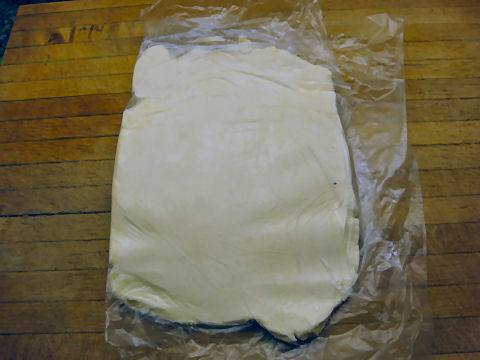
Between sheets of plastic wrap or wax paper flatten out 250 grams of margarine or butter into a rectangle about half the size of a sheet of letter paper (here, of course, we’re instructed to make it half the size of a sheet of A4 paper…).
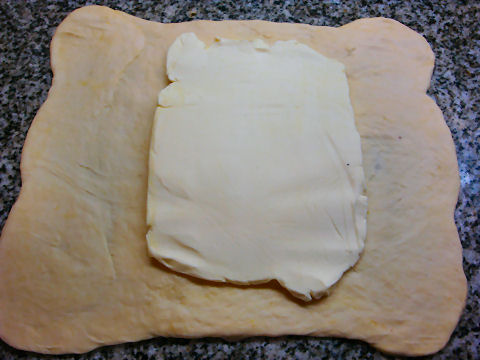
Roll out the dough into a rectangle that is just a bit bigger than that same sheet of paper – enough to cover the butter on both sides. By the way, according to what I’m learning now, this is called “German” puff pastry, with the butter inside – in the “French” or “Brazilian” style you roll out the dough and butter to the same size and it’s folded “in reverse” – with the butter on the outside. I don’t know – I went to a pretty traditionally French technique based cooking school and our butter was on the inside. I’ll give them the Brazilian claim because I don’t know…. There’s also a “Dutch” method which is a quick puff pastry, more for use in things like wrapping a roast or fish – Beef Wellington sort of thing – where you’re not looking for delicacy – it’s a bit more like a tart crust, though not exactly. Perhaps I’ll give these two other methods a shot one day and a step-by-step demo.
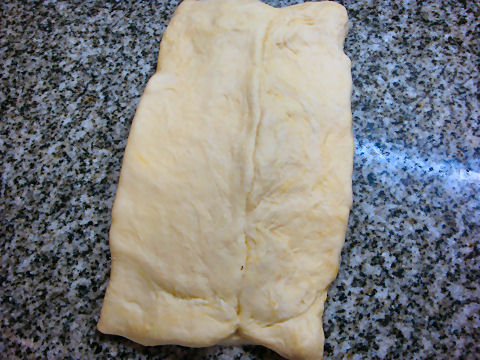
Fold over the ends of the dough so they just meet in the center, and seal all around. When I learned how to do this years ago, and the method outlined in, for example, the classic Larousse Gastronomique, rather than having to seal the ends, which leaves a pocket of dough as you continue that doesn’t have butter in between the layers, though I suppose that it eventually just gets pressed together and disappears, we squared off both dough and butter, and put them at a diagonal to each other and then folded in the four corners – this sealed those outer edges completely, as they were folds… rather than edges. But this seems to work just fine.
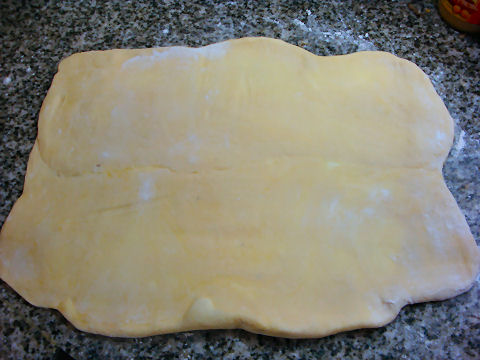
Roll the whole thing out once, to, once again, about the size of that paper, or just a bit bigger.
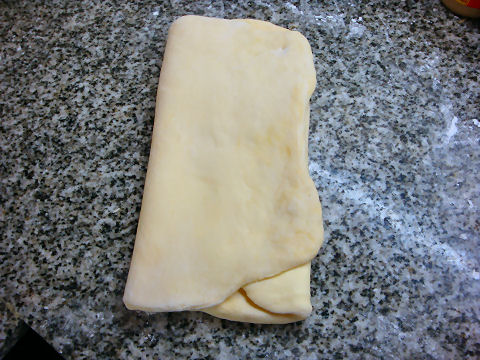
Fold it over like a tri-fold brochure. This is a “simple” fold. A “double” would be to fold it more like a book jacket, with the ends being folded in once to almost meet in the center and then the whole thing being folded over at that midpoint – creating four layers rather than three. Repeat this action twice more, each time turning the dough 90 degrees, and, particularly with butter, refrigerating it for 10 minutes between each – three tri-folds in all, or, five times total – depending on the type of pastry you’re making. I did it three times, then cut it in half, using half to make sfogliatelle and then the other half I tri-folded twice more for, to make palmeras – you’ll see both of those in the upcoming posts.
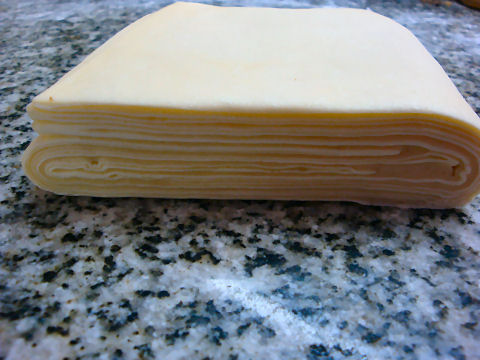
Cutting it in half as I did to make two different things allows you to see the number of layers after three tri-folds – if you stop to think about it, before you start that process you’ve already got two layers of dough, the covering of the butter, so after three tri-folds you’ve got 54 layers (2 x 3 x 3 x 3), as here. If you continue that on to five tri-folds, you’ve got 486 layers, which accounts for how delicate some of those puff pastries get!
If there was ever a good day to bake something .. .this is it.
Thanks for this .. I will try it .. after I have a Martini and think I Can Do Anything !
So far that’s just the base dough – now I have to sit down and write up what to do with it!
Well, that is fine..since I haven’t got a Martini 🙂
But I will go read Step 2 and copy it ..
Are you Puff Danny ?
groan ! sorry sorry lol ~
No Martini? Quel Horeur!
I’ll only use that moniker if you’ll use “Candy Cane”….
Ahh, Candy Kane ( I went to school with a girl with that name … and I remember as a kid, there was a “famous” stripper known as Candy Cane..
I will not call you Puff Danny then, I don’t think I could deal with Candy Cane.
Now I am going back to sfogliatelle …
I thought that might just put an end to the idea….
[…] now that we have our puff pastry made, what to do with it? Let’s start with one of the simplest, palmeras as they’re called […]